Baby Carrier Item Number: Nbz800 a-b from the MOA: University of British Columbia



Description
Coiled cedar root basketry cradle (part a) with slat foundation and sides. Cradle is rounded at the higher, wider proximal end and is tapered and narrow at the distal end. Fully beaded overcast rim. Remainder of the cradle is plain on the inside and decorated with beading and imbrication on the outside. Rim pattern has mainly canary grass with several repeats of alternating cherry bark and grass. There are seven side coiled rows. First two rows repeat a pattern of closely spaced grass chevrons alternating with wider spaced red or dark brown cherry bark chevrons. Rows three and four repeat above pattern in alternating areas. Rows five and six feature three vertical red cherry bark lines alternating with a darker diamond or x-shaped pattern. Row seven is undecorated. No foot. Plain coiled bottom. Tumpline or carrying strap (part b) with wool wefts and multiple element warps is weft-faced plain weave in a light white-brown and red zigzag pattern. On each end of the strap, there is a machine-stitched, hide backed strip of plaid material which has a shell button on the strap end and a button hole at the other. Each end is buttoned over a strip of hide which is tied on each side of the cradle just below the rim with small strips of hide. There is a small piece of cordage tied to one side.
History Of Use
Basketry cradles are thought to be of relatively recent origin by some basketry experts, such as Andrea Laforet of the Canadian Museum of Civilization. They may first have appeared in the late 1800s or early 1900s. In the early to mid 20th century basket makers began expanding their reportoire of shapes and styles for collectors, and many new forms were seen including tea cups, tables, suitcases, and hand bags.
Cultural Context
children; basketry; plant technology
Iconographic Meaning
The design on this basket was identified as snake trails (identified by Sto:lo basket maker Rena Point Bolton).
Narrative
The weaving of this basketry has recently been attributed as possibly being made by Adele Peters of Chehalis. Joan Chapman was able to recognize this cradle as her mother's work based on the design on it, since it is one of the designs she inherited from her mother.
Item History
- Made by Adele Peters ? (Maker) in Harrison Lake, British Columbia, Canada ? before 1930
- Collected during 1930
- Owned by Joan Goodall before January 21, 1980
- Received from Joan Goodall (Donor) on January 21, 1980
What
- Name
- Baby Carrier
- Identification Number
- Nbz800 a-b
- Type of Item
- carrier
- Material
- cedar wood, cedar bark, canary grass, skin, shell, fibre, wool fibre, cherry bark and cedar root
- Manufacturing Technique
- coiled, beaded, woven, sewn, tied, machine stitched and imbricated
- Overall
- height 14.5 cm, width 26.6 cm, depth 67.7 cm
Who
- Culture
- Coast Salish: Sto:lo
- Creator
- Adele Peters ? (Maker)
- Previous Owner
- Joan Goodall
- Received from
- Joan Goodall (Donor)
Where
- Holding Institution
- MOA: University of British Columbia
- Made in
- Harrison Lake, British Columbia, Canada ?
When
- Creation Date
- before 1930
- Collection Date
- during 1930
- Ownership Date
- before January 21, 1980
- Acquisition Date
- on January 21, 1980
Other
- Item Classes
- basketry
- Condition
- good
- Accession Number
- 0599/0001 a-b